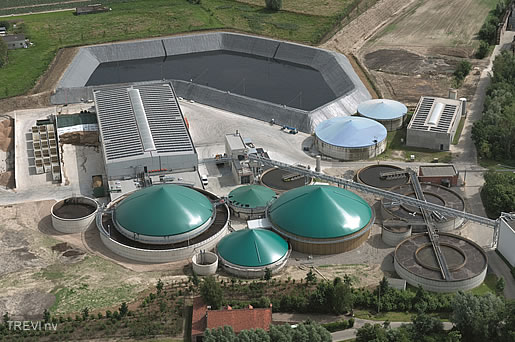Principle
Together with BiogasTec Trevi builds facilities for anaerobic digestion, also called biogas plants. A biogas plant is a plant which - as the name implies - produces biogas. This gas is a renewable energy source based on organic material. This organic material concerns manure, waste and energy crops.
Biogas is certainly not new. Spontaneous fermentation of organic material with formation of gas is a natural process and being applied since ancient times. A biogas plant ensures that the biogas is optimally formed in controlled conditions.
The process occurs in the absence of air (anaerobic) and consists of four consecutive microbiological processes: hydrolysis, acidogenesis (fermentation), acetogenesis and methanogenesis. The complex organic mass (= biomass) is converted finally through these various stages into biogas. Biogas is a mixture of mainly methane and carbon dioxide. This is shown below.
Scheme
The basic principle is always the same: an optimal mix of input streams is collected in a large stirred tank, the digester or fermenter, which is maintained at the proper temperature. The fermentation process generates biogas and digestate. The biogas itself is used as fuel for the production of green electricity and heat. The digestate is a fertilizer which, if required, can be further processed before being used in agricultural applications. The digestate can be further treated with proven manure treatment technology (nitrification / denitrification, evaporation).
An example of an agricultural digester (Agrikracht, site Rumbeke), with indicative figures.
Applications
In the first instance organic biological waste is used as feeding source and where appropriate supplemented with manure and / or energy crops. Biogas can also be extracted from waste water or from historical landfills.
Biogas is currently mainly used for fuel in gas engine cogeneration machines (CHP). The associated generator allows the generation of renewable green electricity that is injected in the power grid.
Further processing of the biogas to a quality comparable to natural gas is also possible. In this case it is called biomethane which can be injected into the natural gas grid or used as transport fuel (bio-CNG) after pressurization.
Example of realisation

Together with BiogasTec five installations have been built:
Albertstroom - Grobbendonck: 150.000 ton/year, 13.0 MWe
Agrikracht – Rumbeke: 46.000 ton/year, 1.1 MWe
G.S.L. – Halle: 52.000 ton/year, 1.2 MWe
Agrikracht – Moorslede, 60.000 ton/year, 1.5 MWe
Digrom Energy – Ardooie, 89.000 ton/year, 3.0 MWe
Leiestroom – Menen, 130.000 ton/year, 6.2 MWe
Approach Trevi
Every biogas project is unique. From this point of view the optimal project concept and design is elaborated. Based on the feed materials (manure, corn, waste) and the desired output (fertilizers, electricity, heat) possible synergies are investigated to accomplish the most cost effective solution for each project. The entire project development is followed up by the sister company BiogasTec. More information can be found on the website www.biogastec.com. The electricity produced is sold by the sister company Trevion.
.jpg)
-1624538992.jpg)